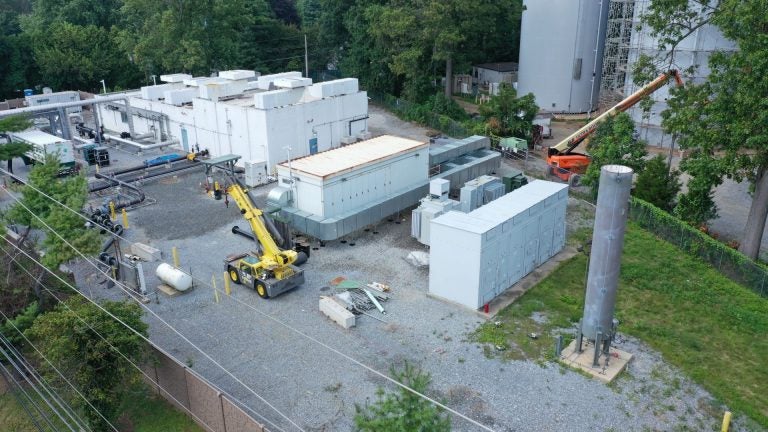Pipeline experts say vapor buildup likely led to explosion at Chester County pump station
For now, independent pipeline experts say the blast appears to have been caused by the relighting of a pilot light.

Sunoco's Boot Road station, site of what the company called a 'backfire on a flare stack' Aug. 5 that residents said sounded like an explosion. (Courtesy of Eric Friedman)
This article originally appeared on StateImpact Pennsylvania.
—
Was Monday’s explosion at a Mariner East 2 pumping station in Chester County a routine maintenance glitch, as Sunoco Pipeline said, or was it a “dry run” for the catastrophe predicted by critics of the natural gas liquids pipelines?
The public won’t know the answer to those questions until state and federal regulators, or Sunoco itself, release reports on an incident that scared residents near the station on Boot Road in West Goshen Township, leaving some to say that they had dodged a bullet.
For now, independent pipeline experts say the blast appears to have been caused by the relighting of a pilot in a flare used by Sunoco for burning off excess gases, at a time when vapor had accumulated there.
The pilot seems to have been extinguished for maintenance, during which time explosive hydrocarbons built up in the tube, and were ignited when the pilot was re-lit, causing the explosion, said Rich Kuprewicz, a pipeline expert who has consulted for the township. He does not have first-hand knowledge of Monday’s event but discussed it based on his experience of how pumping stations work.
“If you shut off that pilot light and didn’t do certain procedures that normally you would follow, you could end up within the flare with combustible gas that, when you did ignite the pilot, it would cause what they call a backfire,” Kuprewicz said. “I’m going to call it what it is: It’s an explosion.”
In 2015, Kuprewicz’s company, Accufacts, concluded in a report for the township that Sunoco had exceeded federal safety requirements in its plans for the pumping station.
On Tuesday, he said that whatever the cause of the incident, Sunoco should clearly and quickly explain how it happened and how it will prevent a recurrence, addressing a public that already has deep misgivings about the safety of the pipelines running through their crowded neighborhood.
“They could argue that it’s a minor backfire, but look, they are in a hyper-sensitive environment where people are just looking for a reason to hang you,” he said. “You just don’t do these things.”
Sunoco, in a statement on Monday, called the explosion a “backfire on a flare stack as the station was brought back on line” after routine maintenance, but did not respond on Tuesday to questions on what it meant by a backfire and why the incident happened.
Kurt Knaus, a spokesman for the Pennsylvania Energy Infrastructure Alliance, which advocates for Mariner East and other pipelines, said public safety concerns are misplaced.
“While some may have been startled by the loud sound, others now are trying to use this incident to heighten concern and play into community fears,” he said. “Routine maintenance is nothing new for any infrastructure project. Considering the multiple layers of regulatory oversight and emergency preparedness in place for these projects, attempts to paint this incident as something it is not are unfortunate.”
In 2014, the township and a citizens group challenged Sunoco’s plan to construct the pumping station and its “vapor control unit.” The suit was settled the following year.
Rich Raiders, an attorney and former environmental officer with Buckeye Energy Services, a distributor of refined petroleum products, said the explosion appears to be the result of a buildup of unburned hydrocarbons while the pilot was unlit.
Engineers allow very small quantities of whatever product is being carried in a pipeline – in the case of Mariner East, ethane, propane or butane – to leak through the pump seal to lubricate the pump, Raiders said. Under normal circumstances, those products are burned off in the flare, but with the pilot out, the material could not be burned.
The buildup could explain why some residents reported a petroleum-like smell in the area for about an hour before the explosion, Raiders said.
“The spark went out, it stopped burning, and it started collecting vapors for over an hour, from what the community people are saying,” he said. “What seems to have happened here is that they were just spewing out that stream for long enough to collect vapors, and then after a while, something sparked the vapors, and you had ‘boom.’”
Gary Hague, who lives about 300 yards from the pumping station, said the explosion was much louder than the ‘backfire’ that Sunoco claimed.
“If that was a car backfire, it had to be 100 cars,” Hague said. “It shook my house violently enough that I thought a meteor hit the roof.”
Hague, 72, a retired truck driver, said he supports an “all of the above” approach to national energy policy but is disappointed by what he said appears to be Sunoco’s “total carelessness and disregard for the community.”
State Rep. Carolyn Comitta, (D-Chester), called on the Public Utility Commission to do an impartial assessment of the explosion, and said that public confusion over whether to evacuate the neighborhood during Monday’s event shows that government and company officials need to do a better job at telling people what to do in a pipeline emergency.
“Communication is sorely lacking, which creates chaos,” she said. “We spend a lot of time and stress because of the lack of timely information and this is a perfect example of that.”
West Goshen Township referred an inquiry about the explosion to regulators including the PUC. The agency said it is reviewing the incident but declined to say when its review might conclude. The federal pipeline regulator, PHMSA, did not respond to a request for comment.
WHYY is your source for fact-based, in-depth journalism and information. As a nonprofit organization, we rely on financial support from readers like you. Please give today.



